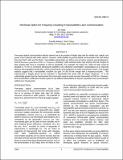Nonlinear Optics for Frequency-Doubling in Nanosatellite Laser Communication
Author(s)
Clark, James; Cahoy, Kerri
DownloadConference paper (800.5Kb)
Metadata
Show full item recordAbstract
Free-space optical communication attracts interest due to its promise of higher data rates for similar size, weight, and power costs compared with radio systems. However, while satellite-to-ground optical communication has been tested from low Earth orbit and the Moon, intersatellite optical links are still an area of active research and development. Second-harmonic generation (SHG, or “frequency doubling”) with nonlinear optics may improve the link margins of laser systems that serve as crosslinks as well as downlinks. For example, the output of a 1550 nm laser could be doubled to 775 nm on command, allowing the satellite to use whichever wavelength is advantageous (e.g. improved detector and propagation properties), without spending the mass budget for an entire second laser system. Link-budget analysis suggests that a nanosatellite crosslink can gain 3-4 dB of link margin with a frequency-doubler. This improvement is largely driven by the reduction in beamwidth that comes with the higher frequency. It is not substantially greater than the improvement that comes with using the same narrower beamwidth at 1550 nm. However, SHG would allow a diffraction-limited system to use different beamwidths for beacon acquisition and communication without any moving parts.
Date issued
2016-08-10Department
Space Telecommunications Astronomy and Radiation (STAR) Lab; Massachusetts Institute of Technology. Department of Aeronautics and AstronauticsPublisher
Utah State University Digital Commons
Citation
J. Clark and K. Cahoy, “Nonlinear Optics for Frequency-Doubling in Nanosatellite Laser Communication,” AIAA/USU Conference on Small Satellites, Aug. 2016.
Series/Report no.
AIAA/USU Conference on Small Satellites;SSC16-VIII-5
Keywords
nonlinear optics, nanosatellites, cubesats, laser communication